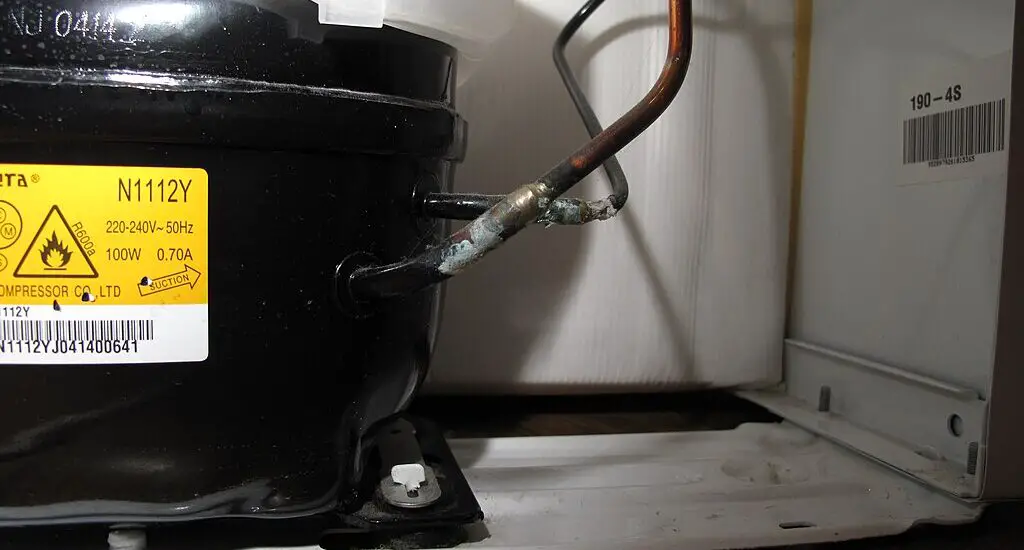If you’re seeking in-depth knowledge about refrigerator compressor output pressure, this guide will be your go-to resource. We’ll cover everything you need to know, from what it is to why it’s important, how to measure it, and what to do if something is off.

Table of Contents
What is Refrigerator Compressor Output Pressure?
Refrigerator compressor output pressure refers to the mechanical force exerted by the refrigerant gas as it moves through the compressor. The compressor, situated at the back or the bottom of your fridge, plays the role of compressing the refrigerant gas from a low-pressure vapor into a high-pressure vapor.
This high-pressure gas then circulates through coils to remove heat from the interior of the fridge, keeping your food cold. Therefore, the output pressure is a critical indicator of the performance and efficiency of your refrigerator’s cooling system.
Why is the Refrigerator Compressor Output Pressure Important?
The compressor output pressure serves as a vital health indicator for your fridge. The following are key reasons why it is important:
Cooling Efficiency: An optimal pressure ensures that the refrigerant circulates efficiently, keeping the interior of the fridge cool. Improper pressure can result in uneven cooling.
Energy Consumption: A compressor working at the right pressure uses electricity more efficiently. High or low pressure can lead to increased energy usage, causing higher electricity bills.
Longevity of the Appliance: Knowing and maintaining the optimal compressor output pressure can prevent excessive wear and tear on the fridge, thereby extending its lifespan.
How to Measure the Refrigerator Compressor Output Pressure
To measure the refrigerator compressor output pressure, you’ll need a specialized tool called a manifold gauge set. Below are the detailed steps:
Preparation: Before you begin, wear protective gloves and goggles for safety. Make sure to unplug the fridge to avoid electrical hazards.
Locate the Compressor: The compressor is typically situated at the back or the bottom. You may need to remove an access panel using a screwdriver.
Identify Service Valves: On the compressor, look for service valves, which may be labeled as ‘low-pressure’ and ‘high-pressure’ or ‘input’ and ‘output.’
Attach Manifold Gauge: Connect the manifold gauge set to the appropriate service valves. The gauges are usually color-coded: blue for low pressure and red for high pressure. You can get this BENTISM AC Manifold Gauge Set from Walmart.
Power On: Plug the fridge back in and turn it on to let the compressor run and stabilize for a few minutes.
Read and Record: Once stable, read the pressure on the gauge. This value should be compared to the manufacturer’s specifications, usually available in the user manual or on the manufacturer’s website.
Check out these other articles…
Bad Smell From Refrigerator Compressor: 3 Causes & Fixes
Roaches in Refrigerator Compressor: Proven Elimination Steps
Dent in Refrigerator Compressor: Fixed in 6 Easy Steps
Refrigerator Compressor Is Too Hot: Fixed in 4 Easy Steps
Refrigerator Compressor is Warm: 3 Easy Solutions
Factors That Affect Refrigerator Compressor Output Pressure
The refrigerator compressor output pressure can vary due to several reasons:
Room Temperature: Higher ambient temperatures can cause the compressor to work harder, affecting the output pressure.
Age and Wear: Older appliances or those that have not been regularly maintained may exhibit fluctuations in output pressure.
Type of Refrigerant: Different refrigerants have different optimal pressure levels. Always consult the manufacturer’s specifications.
What to Do if The Refrigerator Compressor Output Pressure is Off
If the measured refrigerator compressor output pressure deviates from the manufacturer’s recommended range, it’s a red flag. Here’s what you can do:
Check for Leaks: A common issue is refrigerant leakage. Use a leak detector like this Elitech WJL-6000S Freon Leak Detector available at Walmart to inspect all connections and valves.
Consult a Technician: If the issue is not apparent, consult a qualified technician for a thorough diagnostic and possible repair or refrigerant refill.
Consider Replacement: If your fridge is old and repairs are frequent, it may be more cost-effective to replace the appliance.